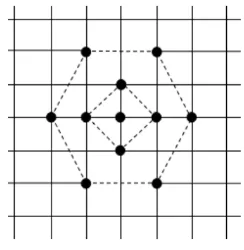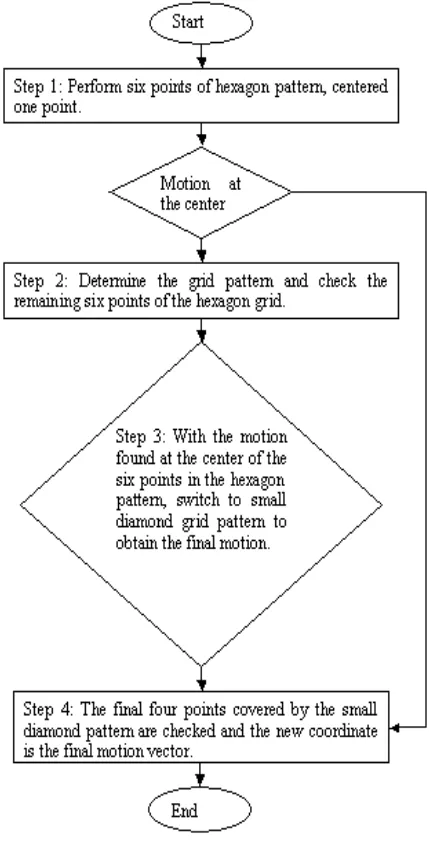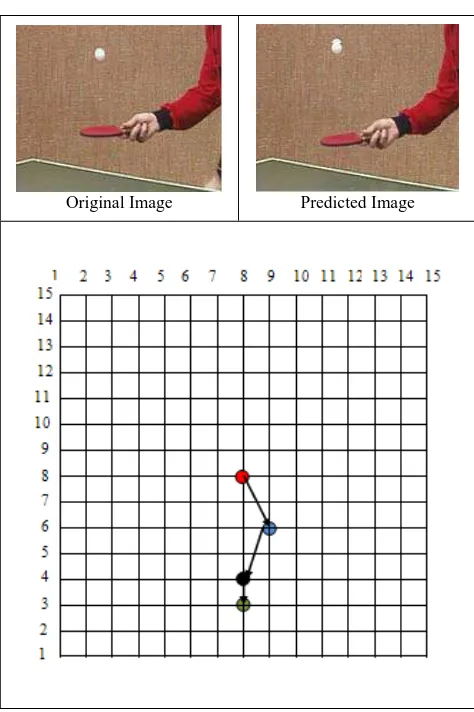Motion Vector Estimation Search using Hexagon-Diamond Pattern for Video
Sequences, Grid Point and Block-Based
S. S. S. Ranjit, S. K. Subramaniam, S. I. Md Salim
Faculty of Electronics and Computer Engineering, Universiti Teknikal Malaysia Melaka, 76109 Durian Tunggal, Melaka, Malaysia.
email: [email protected],
Abstract - Grid and block-based motion vector estimation techniques are proposed for motion tracking in video sequences. The
grid technique is referred to the hexagon-diamond pattern. While, block-based technique is referred to 16 × 16 pixels of blocks in a single frame in video sequences. The hexagon and diamond pattern is applied onto the 16 × 16 pixels blocks in a single frame for motion tracking purposes in video sequences. The hexagon grid pattern will conduct a search to capture the motion in a particular block of the hexagon region before the diamond grid pattern takes place for the fine search. The diamond grid pattern provides accuracy to obtain the best grid vector coordinate for motion tracking purposes. The hexagon-diamond grid vector coordinate can be used to determine whether the object is moving toward the horizontal or vertical plane. The information determined at grid vector coordinate can be used as a reference when referring to the previous frame in video sequence processing. The grid vector coordinate will help to determine the area of interest to be examined based on the coordinate obtained. Besides the grid vector estimation, the Point Signal Noise-to-Ratio (PSNR) is also applied to measure the quality of the video.
Keywords: Hexagon Search, Hexagon Grid Search, Diamond Pattern, Grid Vector, Block Matching, 16 × 16 Pixels Blocks
I. INTRODUCTION
The primary objective in block-matching algorithm (BMA) [1] technique is to minimize the search point while maintaining the performances of the algorithm. The BMA applies the block-based motion estimation approach to determine the motion compensation in the predicted frame. The basic terminology of using the block-matching is, the frames in a video sequence are divided into equally-sized square blocks. Then block comparison is conducted between the current frame and predicted frame [1-18] in order to determine the best-matched motion which is based on the grid search point. In the past years, many researches have been conducted on the block-matching algorithm. Based on the findings, real-world video sequence motion vector is highly correlated to those of its neighboring blocks of the current block [1]. This inspire the development of many fast BMA algorithm such as full search (FS) [1-2], three step search (TSS) [3], new three step search (NTSS) [4], diamond search (DS) [5-6] and hexagon based search (HEXBS) [7]. Many of these developed BMA are being used for motion estimation in the block-based video coding standards, including H.261, H.263, MPEG-1, MPEG-2, MPEG-4 and H.264, due to the simplicity of implementation [1].
II. CURRENT METHODS APPLIED
The FS algorithm is known as the simplest BMA because of the full search characteristics [8]. FS method which exhaustively searches all the candidate points in a block compared with other popular traditional fast BMAs [9]. All the algorithms mentioned in the introduction section have been reported to be able to reduce the computational requirement. Among the well known algorithm, TSS is one of them because of its simplicity [10], significant computational reduction and good performance [11]. TSS algorithm uses a uniformly allocated checking point pattern in the first step, which is not efficient for small motion estimation [3]. Based on this drawback, an improved NTSS algorithm is developed. NTSS tends to achieve much superior performance with fewer number of search points on average [5] compared with TSS. In the first step, NTSS combines the original checking points used in TSS method and eight extra neighboring checking points at the center search window [4]. Halfway stop technique is applied in NTSS to speed up the stationary or quasi-stationary block matching [4].
In the control grid interpolation technique [14], a small number of points in motion, called the grid points, are first estimated in order to minimize the motion compensation error, and then whole frame is motion-compensated, by interpolating the motions between the grid points using the BMA technique [15].
Among various control grid interpolation techniques, the hierarchical grid interpolation [16-17] is known to be the most effective motion compensation technique that overcomes the drawbacks of the block-matching technique. In the hierarchical grid interpolation technique, the input image is segmented into quad tree blocks, so that each block yields the variance of the frame difference less than a predetermined value [18].
In this paper, we propose a hexagon-diamond grid pattern (HDGP) using the block-matching motion vector estimation technique. This technique is implemented based on hexagon and diamond pattern using the grid technique. The grid point’s motion vector coordinate is a 16 × 16 macro-block frame-based motion vector estimation technique. In the HDGP algorithm, the search points for motion are referred as the motion vector coordinate points.
The hexagon-diamond pattern applied as grid points while applying the block-matching technique. Grid motion vector estimation using grid point is for a small number of search points in an image [17-18]. The grid points initially are estimated using the block-matching technique. The block-matching technique will estimate the motion vector during the comparison of grid points in the hexagon and diamond pattern.
III. PROPOSED METHOD
The proposed HDGP algorithm employs two different basic search patterns as illustrated in Fig. 1.
Figure 1. Hexagon-diamond grid pattern.
Hexagon grid pattern comprises seven search points including the center point. Meanwhile, small diamond grid pattern, consists of five search points which is located inside the hexagon including the center point. This small diamond search is to finalize the focused search.
Hexagon is applied because the block displacement of real-world video sequences is mainly in horizontal and vertical directions [19]. Basically, the hexagon algorithm applies the horizontal and vertical directionality search [20].
An illustration in Fig.1 shows a sample of an extracted 16 × 16 block from a frame size of 176 × 144 pixels. Based on mathematical functions, each frame will have 9 blocks horizontally and 11 blocks vertically.
Assume i = horizontal (9 blocks), j = vertical (11 blocks),
Eq. (1) is the formula to extract a single frame into 16 × 16 block sizes.
Since the block-based technique is implemented, Mean Absolute Difference (MAD) is used as the matching criterion to reduce the block-matching computation in practice [21]. Based on the switching strategy with two different grid patterns, the following search method is developed as depicted in Fig. 2.
Eq. (2) is applied to determine the motion vector coordinate during the search. This equation is applied to the entire 16 × 16 block in a frame during the simulation. Eq. (2) is applied in Step 2 in Fig. 2 during the hexagon grid pattern and small diamond grid pattern. Each grid points will be evaluated to compare the best motion vector coordinate of which will then represent the motion tracked in a particular frame during the simulation.
Firstly, all the seven hexagon grid points within the search window are checked. They are located around the motion vector predictor. For each of the seven grid points the motion vector coordinate are checked and compared. Then the final motion vector is obtained at the hexagon grid pattern before switching to the small diamond pattern for the final best motion vector coordinate point. If the final motion vector coordinate is found at the center grid point of the hexagon pattern, then it is switched to step 4; otherwise hexagon pattern is repeated in order to obtain the final motion vector at the center.
form a small diamond grid pattern which will finalize the final best motion vector and make comparison to determine the greatest motion vector coordinate. The four grid points are compared to determine the final best motion vector coordinate.
This is the simple explanation of the searching method used to obtain the final best motion vector coordinate point in the motion tracking video sequences. It will proceed to next frame, if any.
IV. EXPERIMENTAL RESULT AND ANALYSIS To evaluate the performance of the proposed HDGP 16
16 block-based hexagon-diamond grid pattern algorithm, we measure the displacement coordinate to obtain the motion vector. Besides that, the PSNR points and average search points are measured to analyze the performance. The experiment is set as the following. The MAD block size is 16
16 pixels and search window size is 15
15 pixels. Three representative video sequences of 176
144 pixels at 5 frames per second are conducted in this experiment. The results presented in both Table I and Table II is the data for 5 frames per second. Fig. 6 shows the original and predicted images of “Claire”, “Walkingman”, and “Tennis”.Table I and Table II shows HDGP algorithm results for PSNR points and average search points. The data presented in Table I is used to analyse the video sequences quality after applying the HDGP algorithm on the video sequences. While Table II shows the grid search points involved to determine the motion vector tracking coordinates at each processed block in conducted video sequences.
TABLE I. AVERAGE PSNR POINTS
Claire Walkingman Tennis
HDGP 39.60 32.04 27.52
FS 39.93 32.34 32.47
TSS 38.91 31.35 26.39
NTSS 38.91 31.34 28.00
DS 39.04 31.49 27.52
TABLE II. AVERAGE SEARCH POINTS
Claire Walkingman Tennis
HDGP 12 12 12
FS 225 225 225
TSS 25 25 25
NTSS 33 33 33
DS 12 12 12
Table I presents PSNR points obtained for FS, TSS, NTSS, DS HDGP algorithm. HDGP algorithm achieved close performance compared with the FS and DS
algorithms, while outperfoming TSS and NTSS agorithms in terms of PSNR points.
Table II represents the average search points result for each algorithms. The HDGP and DS have the same number of average search points. Here, HDGP could increase the PSNR points measurement because of the compact processing of search points. While, FS, TSS and NTSS have 225, 25 and 33 average search points respectively.
Figure 2. Flowchart of HDGP algorithm.
V. MOTION ANALYSIS AND DISCUSSION In this section, HDGP algorithm presents the grid motion vector analysis for “Claire”, “Walkingman”, and “Tennis” video sequences. Each motion analysis illustration is shown based on the motion vector coordinate for the predicted frame. The obtained average search points in Table II are used to determine the motion vector tracking coordinate. Furthermore, motion vector tracking coordinate is used to examine the related motion area which is known as region of interest.
The motion vector tracking coordinate search starts at coordinate (8, 8). This is because the search system needs to be at the center of the search windows. When the search pattern is at or near to the search window boundary, the checking points outside the search window boundary are excluded. The search is confined only within the search window boundary.
(a) Claire
Original Image Predicted Image
Figure 3. “Claire” motion vector analysis.
Fig. 3 shows the motion analysis for predicted frame “Claire”. During the hexagon motion vector grid pattern search, the motion coordinate at (9, 6) (9, 10) lies along the vertical plane. While for the final best motion vector tracking coordinate, the small diamond grid pattern determines the motion coordinates at (8, 7) lies along the horizontal plane.
(b) Walkingman
Original Image Predicted Image
Figure 4. “Walkingman” motion vector analysis.
(c) Tennis
Original Image Predicted Image
Figure 5. “Tennis” motion vector analysis.
Fig. 5 illustrates the motion analysis for “Tennis” predicted frame. During the hexagon motion vector grid pattern, the motion coordinate at (9, 6) (8, 4) lies along the horizontal and vertical plane. While for the final best motion vector tracking coordinate, the small diamond grid pattern motion vector search determines the motion coordinates at (8, 7) lies along the vertical plane.
VI. CONCLUSION
Hexagon-diamond grid system algorithm is designed to produce motion vector tracking coordinate results. The grid coordinate system can be used to track the movement in the video sequences. Based on the coordinate, a specific area can be highlighted for examination purposes.
ACKNOWLEDGMENT
This paper describes about the research that is ongoing at the Faculty of Electronics and Computer Engineering, Universiti Teknikal Malaysia Melaka.
The authors hope this acknowledgment to some of the contributors will let readers know that the field they are working in or are about to venture is one of the most demanding filed around the globe.
REFERENCES
[1] H. C. Chun, and M. P. Lai, “Adjustable Partial Distortion Search Algorithm for Fast Block Motion Estimation,” IEEE Transactions on Circuits and Systems for Video Technology, 13, pp. 100-110, 2003.
[2] H. C. Chun, and M. P. Lai, “Novel Cross-Diamond-Hexagonal Search Algorithms for Fast Block Motion Estimation,” IEEE Transactions on Multimedia, 7, pp. 16-22, 2005.
[3] T. Koga, K. Iinuma, and A. Hirano, “Motion Compensated Interframe Coding for Video Conferencing,” Proceedings National Telecommunication Conference, New Orleans, L. A. pp. 5.3.1-5.3.5. 1981.
[4] R. Li, B. Zeng, and M. L. Liou, “A New Three-Step Search Algorithm for Block Motion Estimation,” IEEE Trans. On Circuits and Systems for Video Technology, 4, pp. 438-442, 1994. [5] S. Zhu, and K. K. Ma, “A New Diamond Search Algorithm for
Fast Block Matching Motion Estimation,” IEEE Transactions on Image Processing, 9, pp. 287-290, 2000.
[6] J. Y. Tham, S. Ranganath, M. Ranganath, and A. A. Kassim, “A Novel Unrestricted Center-Biased Diamond Search Algorithm for Block Motion Estimation,” IEEE Transactions on Circuits and Systems for Video Technology, 8, pp. 369-77, 1998.
[7] Z. Ce, L. Xiao, L.P. Chau, K.P. Lim, H.A. Ang, and C.Y. Ong, “A novel hexagon-based search algorithm for fast block motion estimation,” IEEE Transactions on Circuits and Systems for Video Technology, 12, pp. 349-355, 2002.
[8] Y. Liu, and S. Oraintara, “A Novel Adaptive Multi-Mode Search Algorithm For Fast Block-Matching Motion Estimation”, International Symposium on Circuits and Systems, 3, pp 977 – 980, 2004.
[9] W. L. Chi, M. P. Lai, and H. C. Chun, “A Novel Kite-Cross-Diamond Search Algorithm for Fast Block Matching Motion Estimation,” IEEE Transactions on Circuits and Systems for Video Technology, pp. 729-732, 2004.
[10] H. Y. Chung, P. Y. S. Cheung and N. H. C. Yung, “Adaptive Search Center Non-Linear Three Step Search”, International Conference on Image Processing, 2, pp. 191 – 194, 1998. [11] J. Lu and M. L. Li ou, “A Simple and Efficient Search Algorithm
for Block-Matching Motion Estimation”, IEEE Transactions on Circuits and Systems for Video Technology, 7, pp. 429 – 433, 1997.
[12] A. Rao and M. Raghavan, “Fast Motion Estimation Algorithms Computation and Performance Trade-Offs”, Multimedia Communication and Networking, 2003.
[13] C. H. Cheung and L. M. Po, “A Novel Cross-Diamond Search Algorithm for Fast Block Motion Estimation”, IEEE Transactions on Circuits and Systems for Video Technology, 12, pp. 1168 – 1177, 2002.
[15] G. J. Sullivan and R. L. Baker, “ Motion Compensation for Video Compression Using Control Grid Interpolation”, International Conference on Acoustics, Speech and Signal Processing, 4, pp. 2713 – 2716, 1991.
[16] P. J. L. van Beek, and A. M. Tekalp, “Object-Based Video Coding Using Forward Tracking 2-D Mesh Layers,” SPIE:Visual Communications and Image Processing San Jose, CA, 3024, pp. 699–710, 1997.
[17] C. L. Huang, and C. Y. Hsu, “A New Motion Compensation Method for Image Sequence Coding Using Hierarchical Grid Interpolation,” IEEE Transactions Circuits and Systems Video Technology, 4, pp.42–52, 1994.
[18] J. S. Lee, R. C. Kim, and S. U. Lee, “A Rate-Constrained Hierarchical Grid Interpolation for Object-Based Motion Compensation” Journal of Visual Communication and Image Understanding, 10, pp. 320-335, 1999.
[19] S. Ranjit, K. S. Sim, R. Besar and C. P Tso, “ Application of Motion Estimation Using Ultrasound Images”, 4th Kuala Lumpur International Conference on Biomedical Engineering, 21, pp 519 – 522, 2008.
[20] T. H. Tsai and Y. N. Pan, “A Novel 3-D Predict Hexagon Search Algorithm for Fast Block Motion Estimation on H.264 Video Coding”, IEEE Transactions Circuits and Systems Video Technology, 16, pp. 1542 – 1549, 2006.


